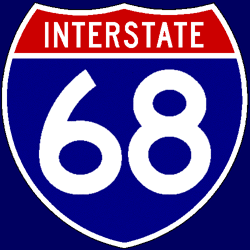 | ||||||||||||||
|
 |
|
[ Back to Highways Main Page ]
 Interstate 68
Total length: 112 miles (180 km) States traversed & length in each:
Major cities along route:
Junctions with non-related Interstates:
Related loops and spurs:
Length I’ve traveled: Entire length Time zones: Counties traversed: A quick hypertext drive: Interstate 68 is the most recent addition to the Interstate system, having only been designated as such in 1989 when the second of road history’s three U.S. 48 designations was removed from that stretch of road. It had been included in the Appalachian Regional Corridor (ARC) system as Corridor E as early as the 1960s, but the Interstate designation did not come until 1989. With improvements to some stretches, I-68 was complete by 1992. It splits from I-79 southwest of Morgantown, WV, and runs around the south and east sides of that city. Upon reaching the northeastern reaches of Morgantown, I-68 crosses Cheat Lake and turns to the east, almost immediately starting up a five-mile, 7% grade to the top of Coopers Rock. From the summit of Coopers Rock to the Maryland border, I-68 is hilly but not especially mountainous; it does, however, become somewhat more mountainous in nature a few miles after crossing into Maryland. From the state line east, I-68 is known as the “National Freeway” in recognition of its paralleling of the old National Road (now U.S. Route 40). A series of short, semi-steep climbs and descents dominate the next 20-25 miles, one of which is the climb to the top of 2,800-ft. (853 m) Big Savage Mountain near milepost 29. From Big Savage Mountain, the next 13 miles (21 km) into Cumberland are all downhill; parts of this grade are as steep as 6%, although not all of it is this steep, as the highway descends almost 2,200 ft. (671 m) over this distance. The alignment through Cumberland itself is horribly substandard, having been built as part of U.S. 40 in the mid-1960s, and bears a 40-mph (64 km/h) speed limit because of its extremely sharp curves and lack of shoulders. (This low speed limit in Cumberland is perhaps the greatest contributing factor to the 40-mph truck speed limit down the hill, all the way in from Big Savage Mountain.) East of Cumberland, I-68 resumes the up-and-down character it had west of town, and carries this on for most of the remainder of its existence. Just a few miles west of its eastern end (and just a stone’s throw south of the Pennsylvania state line), around milepost 74, I-68 passes through a spectacular 381-ft. (116 m) deep cut in Sideling Hill; this cut, which revealed marine fossils from pre-dinosaur days, is considered to be one of the finest rock exposures in the northeastern United States. Several mostly downhill miles later, I-68 terminates at I-70, with direct access to U.S. Route 522 available as well. |













